Medium-Term Business PlanSecond Medium-Term Business Plan
Road Map to 2015 and position of Second Medium-Term Business Plan
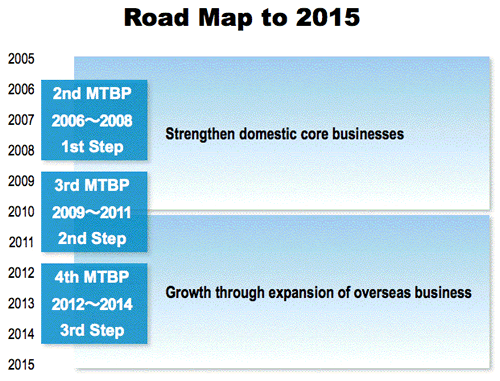
NIPPON PAPER GROUP embarked on its Second Medium-Term Business Plan (MTBP) covering the three years from fiscal 2006 to fiscal 2008, in April 2006. This plan represents the first step toward achieving the operating income target of ¥100 billion established in the Group Vision 2015*.
NIPPON PAPER GROUP has decided to devote the first half of the time until 2015 to strengthening its domestic pulp and paper business and then focus on expanding its overseas business during the second half. The Second MTBP is positioned as an important starting point for achieving the group vision.
- *Group Vision 2015 outlines the goals of NIPPON PAPER GROUP in 2015 and provides a guideline for group management going forward
Business environment affecting Nippon Paper Group
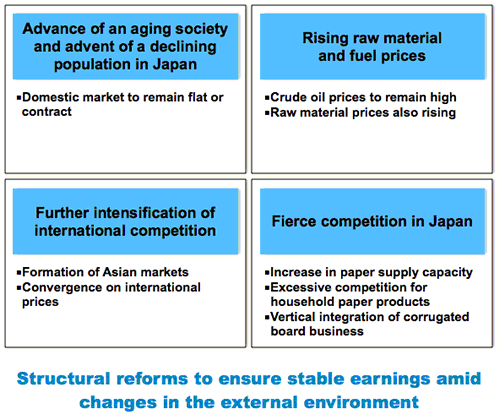
Japan faces the further aging of its society and the advent of a declining population. Consequently, the growth rate of the domestic paper and paperboard market is expected to remain flat or decline.
Rising raw material and fuel prices, including persistently high crude oil prices and higher woodchip prices, are pressuring earnings.
We believe the business environment affecting NIPPON PAPER GROUP will grow more severe due to intensifying international competition, including an increase in the amount of paper imported into Japan, and to fierce competition between domestic manufacturers.
We must independently reform our business structure to ensure stable earnings amid changes in the external environment.
Independent reforms to compete successfully in Asian markets
The primary challenge in the Second MTBP is to strengthen the foundation of domestic businesses through a scrap-and-build program and measures to address the cost of raw materials and fuel. We must pursue independent reforms in terms of size, cost, and technology in order to compete successfully in Asian markets.
During the plan period, we will concentrate investment on domestic core mills to fully leverage the group's strengths and create a robust manufacturing structure with the best manufacturing facilities to compete successfully in Asian markets. Specifically, we will overhaul our domestic manufacturing structure by quickly implementing a scrap-and-build program that centers on the installation of new paper machine at the Ishinomaki Mill of Nippon Paper Industries Co., Ltd.
We will also actively invest in new energy boilers as a response to energy costs and means to reduce carbon dioxide emissions. We will create a foundation for future growth by pursuing a variety of initiatives that marshal the collective strength of the group.
Some specific measures are cited below.
<Strengthen core businesses>
(Paper business)
- Establish the most competitive manufacturing facilities in Asia, including installing the world's most advanced paper machine at the Ishinomaki Mill of Nippon Paper Industries.
- Enhance the basic level of competitiveness of each mill by reducing energy costs with new energy boilers that do not use heavy oil and by augmenting de-inked pulp equipment.
- Lead the market in terms of quality competitiveness by utilizing accumulated technologies, including technology for lightweight, low density printing paper.
- Pursue a more thorough-going distribution and logistics strategy.
(Paperboard business)
- Move to stabilize sales by bringing downstream operations into the group.
<Lay groundwork for restructuring business portfolio>
(Household tissue business)
- Work to enhance productivity and expand sales while pursuing streamlining with an emphasis on reducing logistics and labor costs.
(Raise percentage of overseas sales to 30%)
Bolster the overseas business planning department, set up business locations in target overseas markets, and actively pursue M&A.
(Raise percentage of non-pulp and paper sales to 30%)
Actively pursue M&A and establish new businesses, such as the agribio business.
<Strategically allocate personnel at the group level>
- Rectify any misallocation or duplication of personnel from the standpoint of achieving optimal group-wide allocation.
- Actively reassign personnel to strategic and growth businesses.
- Pursue measures to pass on skills and enhance personnel training for overseas and non-pulp and paper businesses.
<Capital policies and financing>
Implement the following measures to secure the capital investment funds needed to enhance management and operating platforms.
- Maintain credit rating while continuing large-scale investments.
- Effectively use assets and sell idle assets, non-performing or low-performing assets, and unprofitable and non-strategic businesses.
- Diversify fund procurement.
<Group environmental response program>
We are pursuing an environmental response program based on our product strategy in accordance with Action Guidelines of NIPPON PAPER GROUP Charter on the Environmental. This environmental response program is part of our product strategy and involves the integrated management of environment-related factors in all aspects of our business from the procurement of raw materials and fuel to the sale of products. We launched this program at Nippon Paper Industries in 2006 and will expand it to other group companies going forward.
<Reforms to organization and group governance structure>
- Strengthen the functions of NIPPON PAPER GROUP, Inc.
- Develop corporate functions.
Business targets and performance indicators
We have set the following business targets for fiscal 2008, the final year of our Second MTBP.
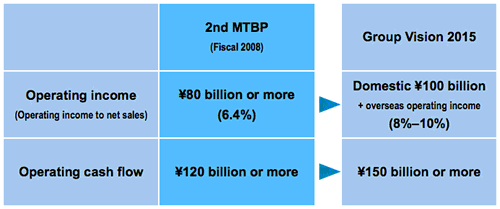
We also target the following performance indicators in fiscal 2008.
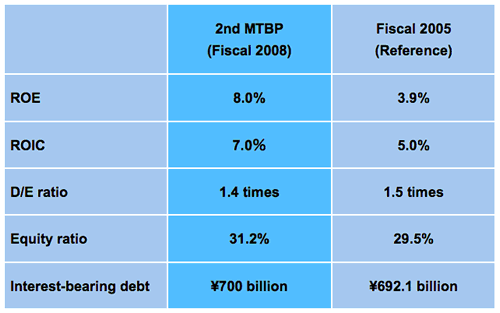
Cash flow plan
We have set the following three-year cash flow plan.
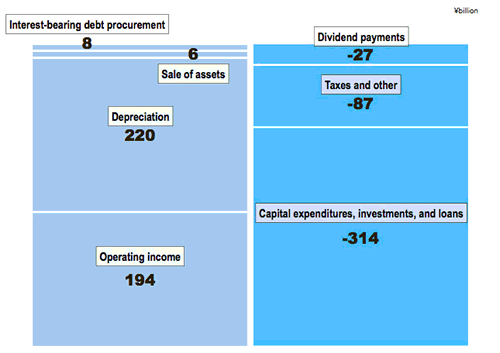
Main capital expenditures
- New energy boilers (reduce oil consumption) ¥60 billion
- Augment de-inked pulp equipment (conserve resources) ¥15 billion
- Scrap and build paper manufacturing facilities (seek international competitiveness) ¥63 billion*
- *The ¥63 billion figure for scrapping and building paper manufacturing facilities includes about ¥8 billion of the ¥15 billion figure for augmenting de-inked pulp equipment.